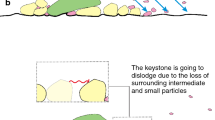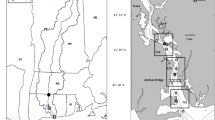Abstract
Estimates of sediment entrainment are required for models of particle transport in lakes and estuaries but are difficult to make because of the multiplicity of factors affecting cohesiveness of surficial sediments. We present results of sediment resuspension studies performed in an annular flume calibrated with laser-Doppler velocimetry. In our experiments, using sediments collected from two sites in the R. Raisin which flows into L. Erie and from one site in the western basin of L. Erie near the mouth of the R. Raisin, we applied shear stresses at the sediment-water interface in steps from 2 to 12 dyne/cm2. Percent water content at the surface of the sediments was either 77 or 74%, and trials were run with and without oxygenating the water overlying the sediments. Entrainment rates as a function of shear stress at the sediment-water interface were best described by a power-law relationship. All but 14% of the variability in the power law expression was due to shear stress and percent water content; the variability not accounted for was due to differences in particle size distributions, chemical properties, and biological activity in the sediments.
Similar content being viewed by others
References
Bale AJ & Morris AW (1987) In situ measurement of particle size in estuarine waters. Estuarine, Coastal and Shelf Science 24: 253–263
Deardorff JW & Yoon SC (1984) On the use of an annulus to study mixed-layer entrainment. J. Fluid Mech. 142: 97–120
Frostick Lynne E & McCave IN (1979) Seasonal shifts of sediment within an estuary mediated by algal growth. Estuarine and Coastal Marine Science 9: 569–576
Fukuda MK (1978) The entrainment of cohesive sediments in freshwater. (Ph.D. thesis, Case Western Reserve Univ., Cleveland, Ohio)
Fukuda MK & Lick W (1980) The entrainment of cohesive sediments in freshwater. J. Geophys. Res. 85: 2813–2824
Gust G (1976) Observations on turbulent drag reduction in a dilute suspension of clay in seawater. J. Fluid Mech. 75: 29–47
Holland AF, Zingmark RG & Dean JM (1974) Quantitative evidence concerning the stabilization of sediments by marine benthic diatoms. Mar. Biol. 27: 191–196
Kirk JTO (1985) Effects of suspensoids (turbidity) on penetration of solar radiation in aquatic ecosystems. Hydrobiologia 125: 195–208
Krone RB (1983) Cohesive sediment properties and transport processes. In: Shen, Hung Tao (Ed) Proc. Conf. Frontiers in Hydraulic Engineering, MIT, Cambridge, Mass. ASCE, NY (pp 66–78)
Lavelle JW & Mofjeld HO (1987) Do critical stresses for incipient motion and erosion really exist? J. Hydraul. Eng. 113: 370–385
Lavelle JW, Mofjeld HO & Baker ET (1984) An in situ erosion rate for a fine-grained marine sediment. J. Geophys. Res. 89: 6543–6552
Lee DY, Lick W & Kang SW (1981) The entrainment and deposition of fine-grained sediments in Lake Erie. J. Great Lakes Res. 7: 264–275
Lerman A (1979) Geochemical Processes. Water and Sediment Environments. John Wiley and Sons, NY
Lick W & Kang SW (1987) Entrainment of sediments and dredged materials in shallow lake waters. J. Great Lakes Research 13: 619–627
Mehta AJ, Parchure TM, Dixit JG & Ariathurai R (1982) Resuspension potential of deposited cohesive sediment beds. In Kennedy VS (Eds) Estuarine Comparisons. (pp591–609), Academic Press, NY
Nowell ARM, Jumars PA & Eckman JE (1981) Effects of biological activity on the entrainment of marine sediments. Mar. Geol. 42: 133–153
Nowell ARM & Jumars PA (1987) Flumes: Theoretical and experimental considerations for simulation of benthic environments. Oceanogr. Mar. Biol. Ann. Rev. 25: 91–112
Melack JM (1985) Interactions of detrital particulates and plankton. Hydrobiologia 125: 209–220
Page AL, Miller RH & Kenney DR (1982) Methods of soil analysis. Part 2, Chemical and Microbiological Properties. Am. Soc. Agronomy and Soil Science Soc. of America. Madison, WI
Paul JF, Kasprzyk R & Lick W (1982) Turbidity in the western basin of Lake Erie. J. Geophys. Res. 87: 5779–5784
Schlichting H (1968) Boundary-Layer Theory. McGraw-Hill, NY
Sheng YP & Lich W (1979) The transport and resuspension of sediments in a shallow lake. J. Geophys. Res. 84: 1809–1826
Tsai CH & Lick W (1985) Entrainment of Long Island South Sediments. A report to the U.S. Environmental Protection Agency. Dec. 1985
Weiner BB (1973) Particle and droplet sizing using Fraunhofer diffraction. In: Barth HG (Ed) Modern Methods of Particle Size Analysis (pp135–172) Wiley Interscience, NY
Author information
Authors and Affiliations
Rights and permissions
About this article
Cite this article
MacIntyre, S., Lick, W. & Han Tsai, C.H.T. Variability of entrainment of cohesive sediments in freshwater. Biogeochemistry 9, 187–209 (1990). https://doi.org/10.1007/BF00000598
Issue Date:
DOI: https://doi.org/10.1007/BF00000598




